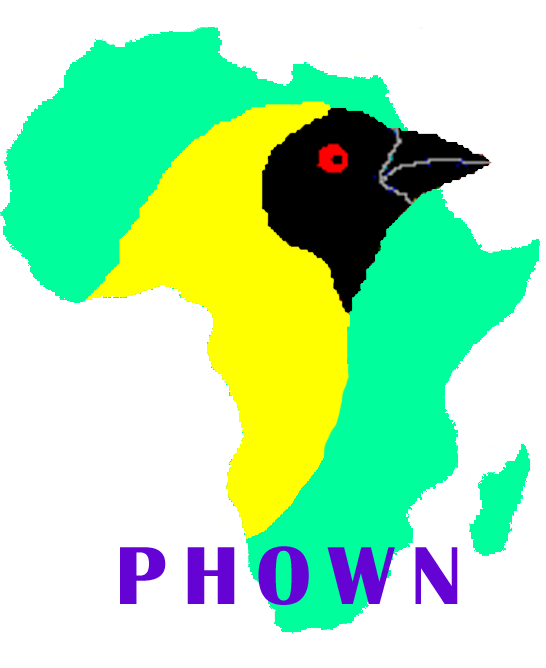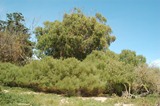Weaver species
Choose different species from drop-down list and press 'Go' button. See Full species list.Bocage's Weaver Ploceus temporalis
IUCN: Least concern Discovery: 077Categories: golden, blue eggs, palm,
News items about species
Discovery
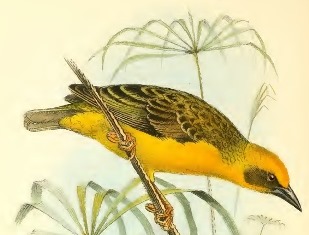
figure from Shelley (1905) 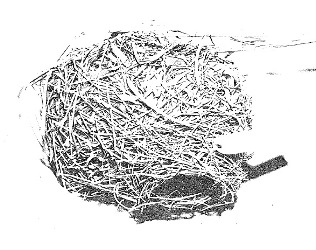
figure from Hall (1960) 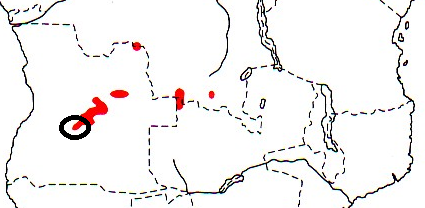
distribution, type locality circled IntroductionBocage's Weaver was formally described by Jose Vicente Barbosa du Bocage, a Portuguese zoologist and politician. He was curator of the Lisbon Museum, and described several other weavers.Bocage's Weaver was collected by Jose Alberto de Oliveira Anchieta, a Portuguese explorer and naturalist, who collected a large number of birds in Angola. In 1867 the Portuguese government hired Anchieta as a naturalist but probably also as a secret agent and informer in the Caconda region of Angola. Anchieta lived in Caconda, explored the area and sent many specimens and letters to his scientific correspondents in Lisbon. Anchieta discovered Bocage's Weaver near Caconda, at the south-western edge of the range of this weaver. Anchieta sent a crate of specimens to Lisbon of 126 birds collected between 1879-80, including a single male specimen of Bocage's Weaver. The Latin name of Bocage's Weaver refers to the olive mask on the face ("temples"). The first English name was simply translated to Temporal Weaver Bird, but later authors gave an English name after the describer of the species. The first illustration of the Bocage's Weaver was of the type published in Shelley (1905). The second illustration for the species was a photo of a nest, published by Hall (1960). Scientific citationHyphantornis temporalis Bocage 1880 Jorn. Sci. Math. Phys. Nat. Lisboa, 7, p.244 Cacunda, Angola.Meaning of namestemporalis, Latin: temporalis, of the temples of the head (tempus, the temples).First English nameTemporal Weaver Bird (Layard 1884).Alternate namesAngola Golden Weaver, Benguela Weaver-bird, Bocage's Golden Weaver.CollectorJose de Anchieta.Date collected1879-1880.Locality collectedCaconda, Angola.Type specimensThe type specimen was in the Museum of Lisbon, before a fire destroyed the museum. |
The above is based on Weaver Wednesday 2, a weekly series about the discovery of each weaver species.
This species text first appeared as
Weaver Wednesday [194] - Discovery [77]: Bocage's Weaver on 2016-03-02
1. Basic biology
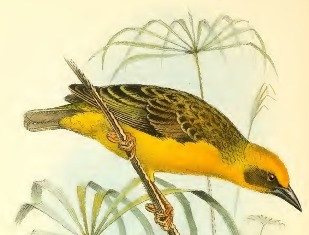
figure from Shelley 1905 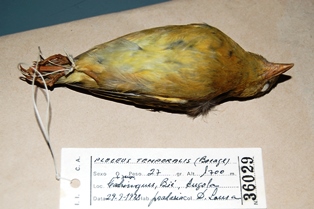
Lubango specimen 36029 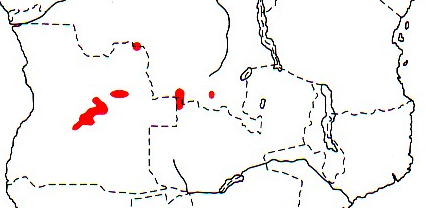
Distribution. Bocage's Weaver is found in central and north-east Angola, southern DRCongo and north-west Zambia (see map left based on Birds of Africa). No subspecies are recognised in this little-known species. Habitat.
Bocage's Weaver inhabits bushes and trees near water, usually in dambos, also in rank grassland and tall forbs alongside streams and at the edges of marshes.
Food. Bocage's Weaver forages in flocks of up to 50 birds. Its diet is insects, including beetles, grasshoppers and caterpillars. Spiders have been found in the stomach of a chick. Breeding.
Bocage's Weaver is probably polygynous. It is a colonial species and colonies of more than 30 nests at one site and up to 20 in one tree have been recorded. The nest is ovoid, and the entrance below may have a short entrance tunnel. The nest is loosely woven from grass stems or strips of grass blades and palm leaves. The nest has a ceiling made of leaf blades and grass heads. Grass seedheads are used as lining. The nest is suspended from a branch over water or in elephant grass next to rivers.
The clutch is 2 eggs, and they are plain sky-blue, similar to Cape Weaver eggs. There is no information on incubation and nestling periods. Brood parasitism by the Diederik Cuckoo Chrysococcyx caprius has been recorded in Zambia. |
The above is based on Weaver Wednesday, a weekly series about weaver species.
This species text first appeared as
Weaver Wednesday [68]: Bocage's Weaver on 2013-10-02
2. Breeding facts
| Pair bond Probably polygynous Breeding season May, Aug and Oct in Angola, Aug-Oct in Zambia Nest site suspended from branch over water or in elephant grass alongside river Nest building no information Colony size Colonial; more than 30 nests at one site and up to 20 in one tree Clutch size 2 eggs (mean in Zambia) Egg colour plain sky-blue Egg size average size of 20 eggs 23.7 x 15.6 mm (Zambia) Incubation no information Chicks and nestling period no information |
Breeding information based on Handbook of the Birds of the World, Vol. 15.
3. Photos of Weaver Nests
 Vm 29114 |  Vm 26201 |  Vm 14705 |  Vm 12893 |  Vm 12090 |  Vm 8413 |
Thumb-nails of most recent PHOWN records - click on one to see its full record
See all PHOWN records for this species here.
PHOWN (Photos of Weaver Nests) provides valuable info on breeding distribution and colony sizes of weavers.
You can contribute by registering and submitting photos at Virtual Museum webpage.
4. Breeding distribution
Google map showing distribution (For species with small ranges you need to zoom in at the correct area to see the range):
yellow blob - range of weaver species; read more about this here.
![]() - PHOWN records with photos
- PHOWN records with photos
![]() - PHOWN records with no photos (Nest Record Cards, other records)
- PHOWN records with no photos (Nest Record Cards, other records)
![]() - Birdpix records
- Birdpix records
![]() - comments on out of range records, or interesting records
- comments on out of range records, or interesting records
![]() - type locality
- type locality
CLICK on the marker on the map to see individual record details.
5. Range changes
Not South African speciesThe above is based on Weaver Wednesday 3, a weekly series about range changes in South African weaver species.
This species text first appeared as
n/a







